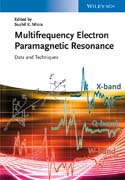
The first comprehensive review of the field, Handbook of Multifrequency Electron Paramagnetic Resonance mines the recently developed experimental and theoretical methods as well as the most current experimental EPR data. Written by a team of experts with a strong expertise in developing EPR instrumentation and applying it to condensed matter, proteins, and even for in–vivo studies, this timely presentation contains roughly 60% data tabulation. Coverage includes hyperfine splittings and g–factors for aminoxyl radicals that allow physicists and chemists to identify and interpret substances and processes by means of EPR techniques. INDICE: PREFACE CHAPTER I. INTRODUCTION Sushil K. Misra, Physics Department, Concordia University CHAPTER II. RAPID SCAN EPR Sandra S. Eaton, Richard W. Quine, Mark Tseitlin, George A. Rinard, Deborah G. Mitchell, and Gareth R. Eaton; Department of Chemistry and Biochemistry, University of Denver 1. The scope of rapid scan EPR a. Magnetic field scans b. Frequency scans c. Relation to CW EPR and Pulsed EPR 2. How to select acquisition parameters a. Line width b. Relaxation times c. Resonator bandwidth effects 3. Post–acquisition treatment of rapid scan EPR spectra a. Deconvolution of linear scans b. Deconvolution of sinusoidal scans 4. Simulation of rapid scan spectra 5. Scan coil design 6. Scan driver design a. Linear drivers b. Sinusoidal driver c. Reduced duty cycle driver 7. Use of ENDOR type coils and RF amplifiers for very fast scans 8. Resonator design 9. Background signals a. Cause b. Methods of removal from rapid scan spectra 10. Examples of applications a. Long relaxation times b. Short relaxation times c. Estimation of relaxation times d. Spin trapped radicals e. Imaging 11. Rapid scan EPR with small modification of routine commercial spectrometer 12. Signal to noise comparison with CW and pulse 13. Extension of the technology to scans shorter relative to relaxation times 14. Range of applications relative to CW and pulse CHAPTER III. MULTIFREQUENCY TRANSITION ION DATA TABULATION Sushil K. Misra, Sean Moncrieff, and Stefan Diehl Physics Department, Concordia University I. Introduction II. Tabulations III. References CHAPTER IV. COMPILATION OF HYPERFINE SPLITTINGS AND g–FACTORS FOR AMINOXYL (NITROXIDE) RADICALS Lawrence J. Berliner Department of Chemistry and Biochemistry, University of Denver I. Introduction II. Tabulations III. References CHAPTER V. COMPUTATIONALMODELING AND LEAST–SQUARES FITTING OF EPR SPECTRA Stefan Stoll Department of Chemistry, University of Washington 1. Introduction 2. cw EPR in solids 2.1 Powder average 2.2 Theory levels 2.3 Line broadenings 3. cw EPR in liquids 3.1 Fast–tumbling regime 3.2 Slow–tumbling regime 3.3 Chemical exchange 4. ENDOR 5. Pulse EPR 6. Least–squares fitting 6.1 Algorithms 6.2 Objective functions 7. Outlook Index
- ISBN: 978-3-527-41222-8
- Editorial: Wiley VCH
- Encuadernacion: Cartoné
- Páginas: 296
- Fecha Publicación: 19/03/2014
- Nº Volúmenes: 1
- Idioma: Inglés
